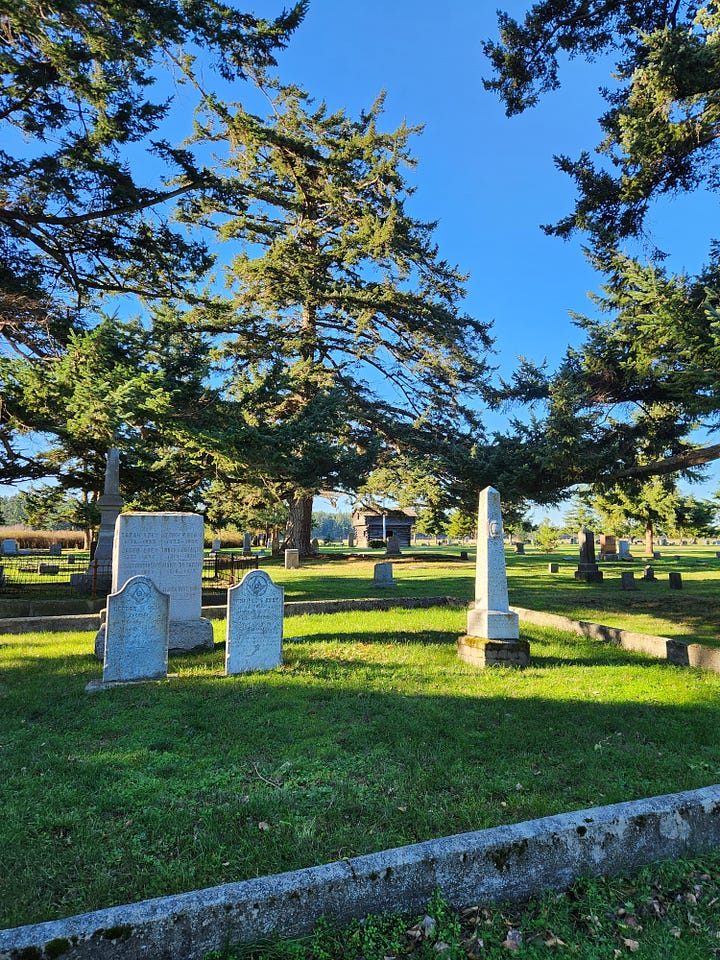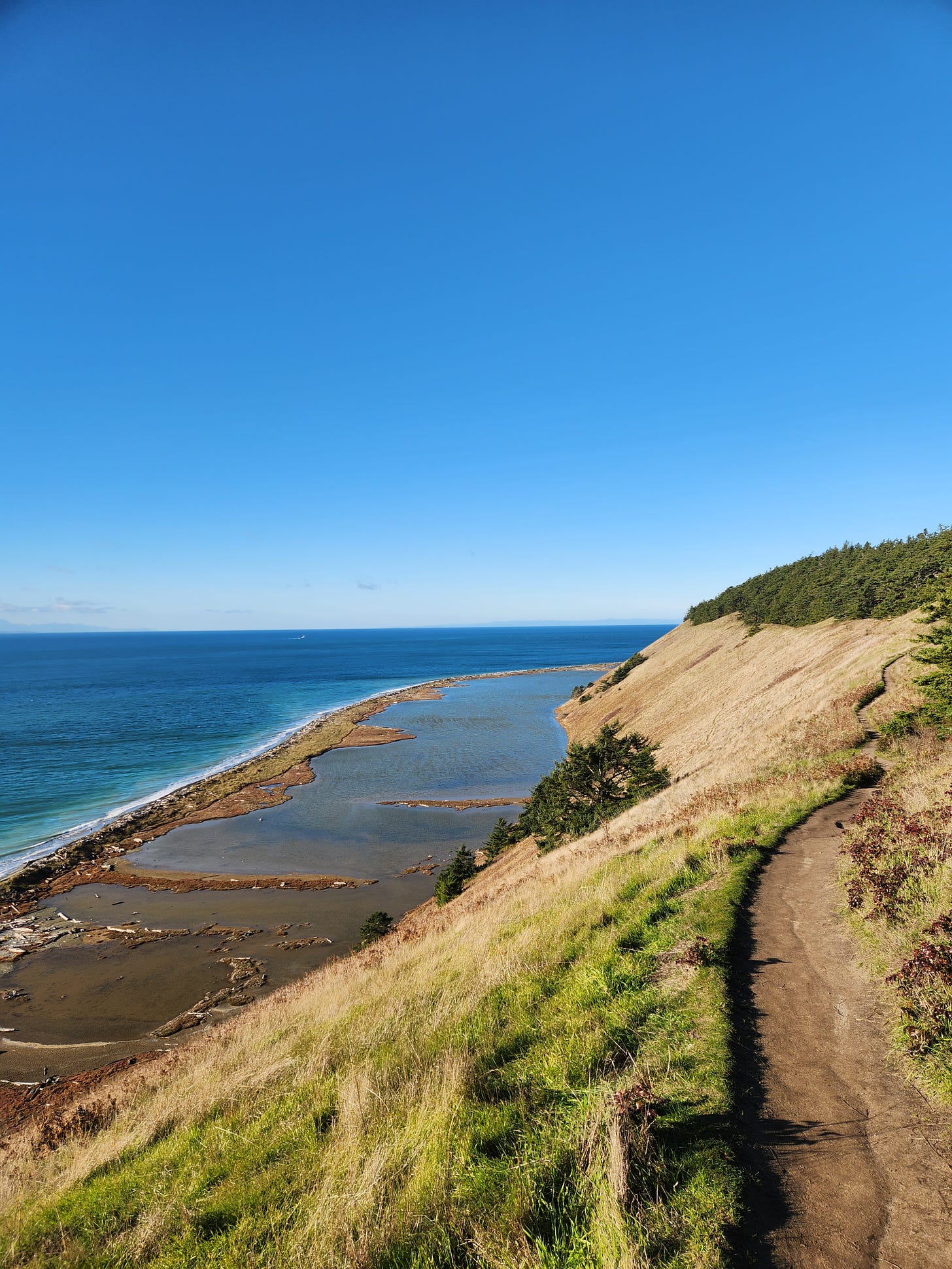In western Washington, Thanksgiving is a gamble. Dreary weather happens more often than not. One childhood holiday, a weather-related power outage spoiled many of my friends’ dinners. This year, we were treated to a glorious Pacific Northwest autumn day. This allowed me to take The Field Trip on Thanksgiving Day. Read on!
Whidbey Island
We spent Thanksgiving on Whidbey Island with family. As a child, Whidbey Island always was a favorite place to visit. It involved taking a ferry or going over a spectacular bridge, and the ultimate destination usually was Fort Casey, a military installation-turned-state park that lit up a boy’s imagination of wartime heroics. As an adult, I’m drawn more to the natural beauty and family who lives on the island. Maturity takes many forms, I guess.
Ebey’s Landing National Historical Reserve
On our way to the house where my spouse grew up, we stopped at Ebey’s Landing National Historical Reserve, a spot partway down the island and about two-thirds of the way to our destination. It’s situated at a low, skinny point on the island offering views of the Olympic Mountains to the west and the Cascades to the east.
The beauty of the spot is undeniable. The mountain views captivate on clear days. The water views overpower the senses on any day. Sometimes, the wind nearly blows you over, too. On Thanksgiving, the wind bit through jackets at the parking lot. We headed west, toward Admiralty Inlet.
In no time, an old wooden home appeared, but my eyes glanced past it to the blockhouse. It dates to the period of widespread wars in the Northwest between invading settlers and resisting Indigenous groups in the mid-1850s. The Ebeys arrived in 1850 with a much broader wave of people claiming Oregon Country as their own. The fact that wars broke out within a handful of years suggests the disruptive presence of settlement.
On Thanksgiving, a time that commemorates (and idealizes) comity amid conflict, the blockhouse stood out with more-than-normal symbolism.
We kept walking along a fenceline toward Puget Sound. We were traversing the first homestead on the island. The guiding law was the Oregon Land Donation Act, calling the question of who was donating the land. The prairie to our left remains open farmland and funnels right down to Puget Sound. Halfway down, a wooden sign marks the original boundary, the advent of private property on the island.
Ridge Walking
Just before reaching the water, with a Washington State Ferry sailing between Port Townsend and Coupeville, we took a trail along a ridge high above the beach. In a few steps of incline, we moved from prairie edge to forest edge. This orientation changed the feel of the natural scene more than you might imagine.
An agricultural landscape yielded to forests and sea, a bigger environment, a larger stage, seemingly. As we walked a couple miles, my eyes kept surveying the watery horizon and air. A bald eagle zipped from behind me closer than is typical.
This view scans over Admiralty Inlet and the entrance to Puget Sound—hence the three forts built here just before the Spanish-American War. On this day, the water was not busy, and on the trail we met friendly people ambling while, presumably, their turkeys were cooking at home. The low, late-autumn sun warmed us and, for once, the wind remained slight.
High tide was about to hit, so we decided against the trip back by beach, which is part of the Pacific Northwest Trail (see earlier newsletter), but our eyes remained fixed below at the rhythmic rolling waves.
Reminders
Once nearly back, we detoured to see some old outbuildings, something I’d never noticed. These barns came from an era quite different form the blockhouse, 1930s compared to 1850s, a result of one type of persistence.
At the end of the trail, back at the parking lot, I wandered for the first time into the cemetery. There was Isaac Ebey’s headstone; in the distance, another blockhouse. Ebey was killed in 1857 in a raid by northern tribes (likely the Kake), led by a woman avenging the death of a relative.


On social media, I saw one person comment that the story of Thanksgiving is the story—an exaggerated one to be sure—of a path not taken, one of coexistence rather than competition and colonization. At Ebey’s Landing on Thanksgiving, I was reminded of the more common, violent path, amid beauty. The American landscape is dotted like this whenever we look.
Final Words
The theme of knowing the past embedded in a current landscape is common in my essays, representative examples are here and here. As a historian, I typically researched a period much later than the one of (re)settlement, but I did write an essay once with similar themes about this period in Idaho that you can find here.
Did you miss my article on Skagit’s white birds of winter from last week?
Deals
It’s the time of year for deals. University of Oklahoma Press is offering its books for 40% off, including my award-winning An Open Pit Visible From the Moon. Just use the code 18HLDY23 when checking out.
Also, I’m offering a 20% discount between Thanksgiving and New Years for subscribers to Taking Bearings. I hope you’ll consider supporting my work and enjoying access to extra features including a monthly interview with another writer or artist.
Taking Bearings Next Week
Last week, I wrote about certifying organic food. I think for The Library next week I’ll dive into some classic writing about agriculture to stick with that theme. Stay tuned!






